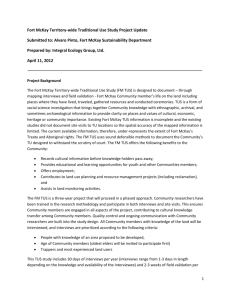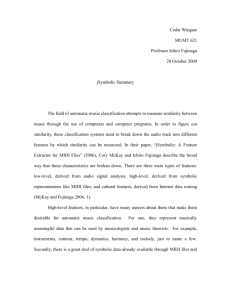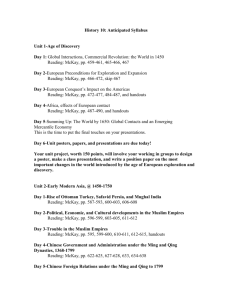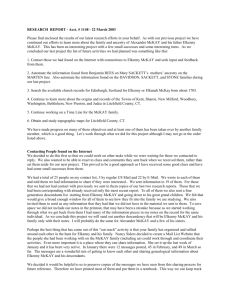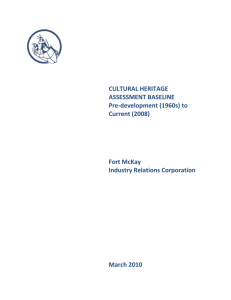TT Project Update April 2012 - Fort McKay Sustainability Department
advertisement
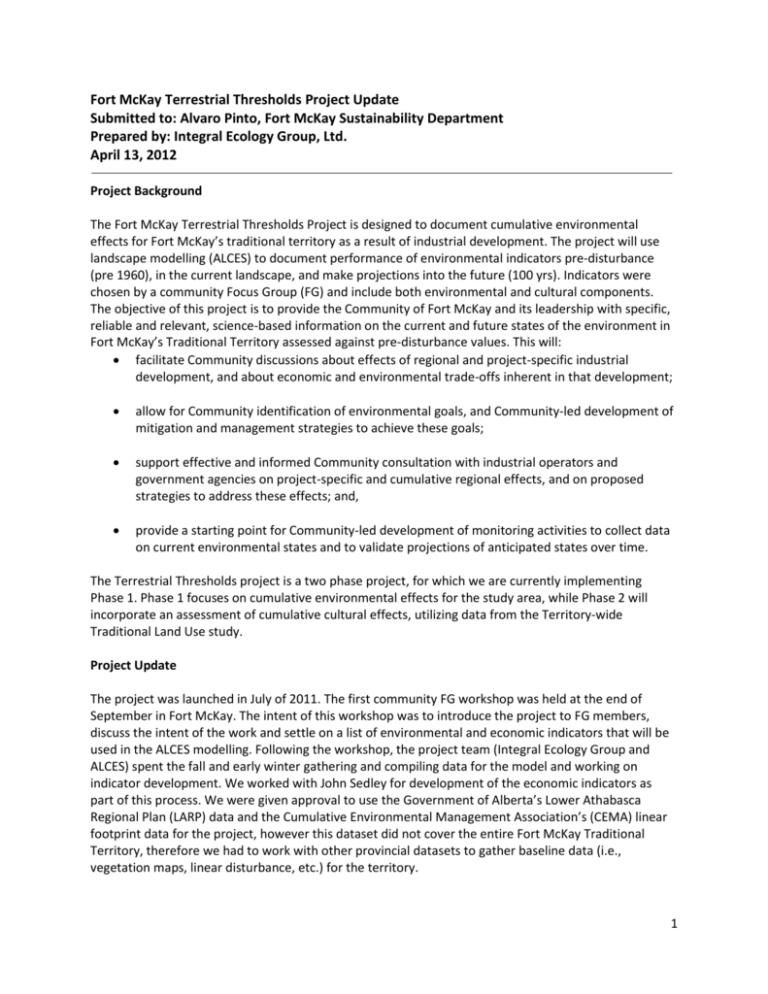
Fort McKay Terrestrial Thresholds Project Update Submitted to: Alvaro Pinto, Fort McKay Sustainability Department Prepared by: Integral Ecology Group, Ltd. April 13, 2012 Project Background The Fort McKay Terrestrial Thresholds Project is designed to document cumulative environmental effects for Fort McKay’s traditional territory as a result of industrial development. The project will use landscape modelling (ALCES) to document performance of environmental indicators pre-disturbance (pre 1960), in the current landscape, and make projections into the future (100 yrs). Indicators were chosen by a community Focus Group (FG) and include both environmental and cultural components. The objective of this project is to provide the Community of Fort McKay and its leadership with specific, reliable and relevant, science-based information on the current and future states of the environment in Fort McKay’s Traditional Territory assessed against pre-disturbance values. This will: facilitate Community discussions about effects of regional and project-specific industrial development, and about economic and environmental trade-offs inherent in that development; allow for Community identification of environmental goals, and Community-led development of mitigation and management strategies to achieve these goals; support effective and informed Community consultation with industrial operators and government agencies on project-specific and cumulative regional effects, and on proposed strategies to address these effects; and, provide a starting point for Community-led development of monitoring activities to collect data on current environmental states and to validate projections of anticipated states over time. The Terrestrial Thresholds project is a two phase project, for which we are currently implementing Phase 1. Phase 1 focuses on cumulative environmental effects for the study area, while Phase 2 will incorporate an assessment of cumulative cultural effects, utilizing data from the Territory-wide Traditional Land Use study. Project Update The project was launched in July of 2011. The first community FG workshop was held at the end of September in Fort McKay. The intent of this workshop was to introduce the project to FG members, discuss the intent of the work and settle on a list of environmental and economic indicators that will be used in the ALCES modelling. Following the workshop, the project team (Integral Ecology Group and ALCES) spent the fall and early winter gathering and compiling data for the model and working on indicator development. We worked with John Sedley for development of the economic indicators as part of this process. We were given approval to use the Government of Alberta’s Lower Athabasca Regional Plan (LARP) data and the Cumulative Environmental Management Association’s (CEMA) linear footprint data for the project, however this dataset did not cover the entire Fort McKay Traditional Territory, therefore we had to work with other provincial datasets to gather baseline data (i.e., vegetation maps, linear disturbance, etc.) for the territory. 1 ALCES modelling is currently underway, this includes results for the pre-disturbance landscape (Ranges of Natural Variation for the indicators), the current landscape, and “Business-as-Usual” (BAU) simulations into the future (i.e., based on if development was to continue at the same pace as it is currently). The second workshop with the FG will be held in May to present these results and to begin to discuss alternative management scenarios (including mitigation and landscape planning different than the BAU case) that the FG, as representatives of the larger Community, would like to employ to achieve desired future landscape conditions. Following this workshop, we will integrate the mitigations and management options the FG suggests into a model run to project the status of the future traditional territory based on these management actions suggested by the community. The intent will be to determine what level of management and mitigation is required to allow for healthy indicators in the landscape (e.g., healthy moose populations that support traditional harvest). The indicator list for this project includes both environmental and economic indicators, and is as follows: 1. 2. 3. 4. 5. 6. 7. 8. 9. 10. Moose population Moose habitat Berries – cranberries and blueberries Index of Native Fish Integrity Linear Edge Density – amount of linear disturbance in the landscape Area of undeveloped land Fisher Commodity Production Net Revenue to Companies Money to Fort McKay – from agreements, group of companies and jobs 2



